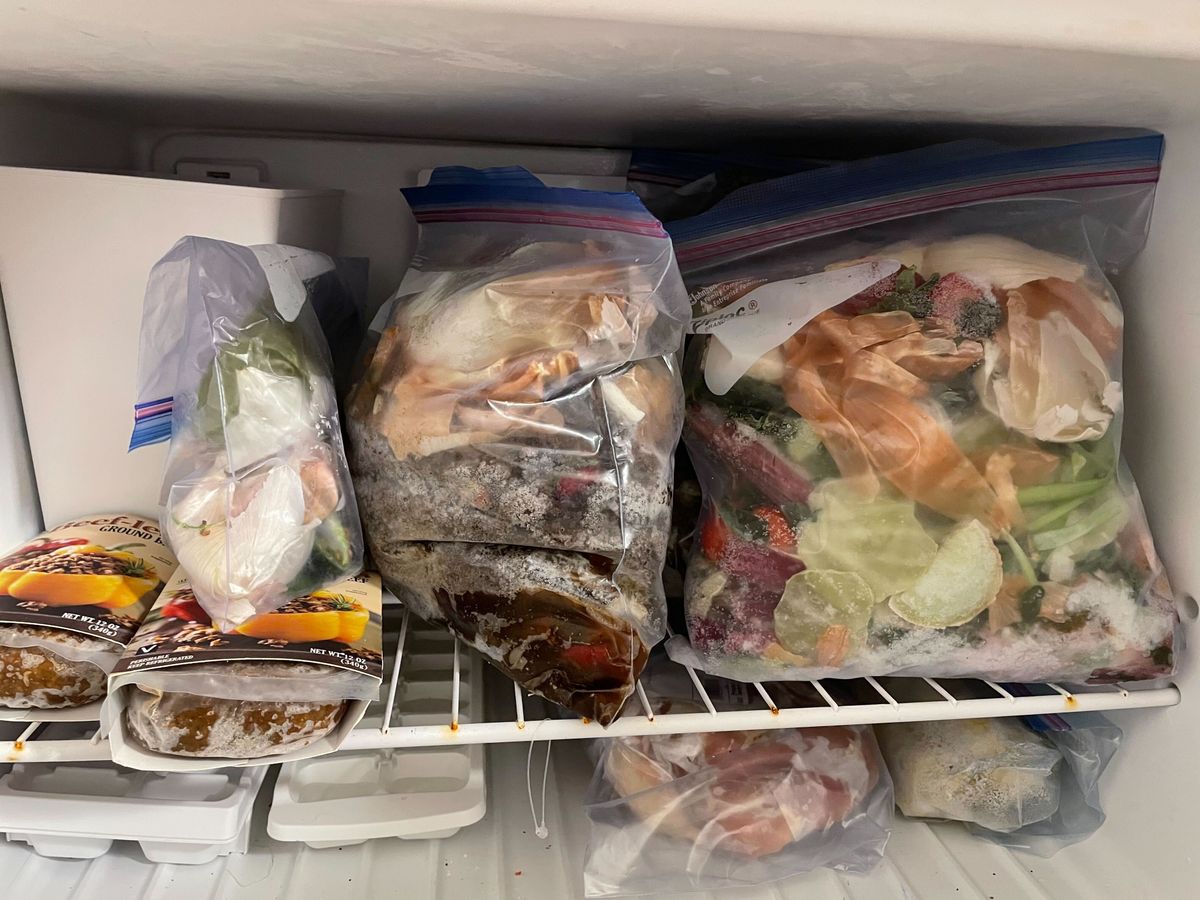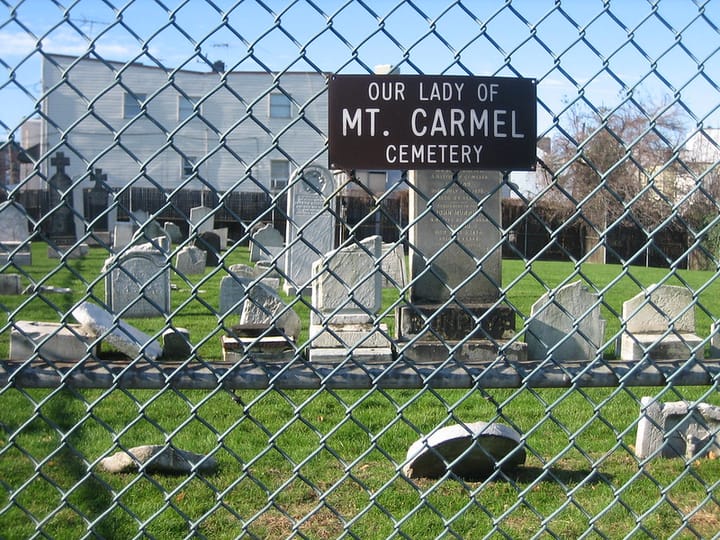Universal composting is almost here, so where is everyone storing their food scraps?
Curbside composting comes to Brooklyn and Manhattan this week; we got some pro tips on making space for it in your apartment.

By Tim Donnelly
This is a huge week in the city’s long and colorful war on waste. After a decade-long odyssey that began in waning days of the Bloomberg administration and took a detour when compost collection was cut off during 2020 pandemic lockdowns, curbside composting expands to all of Brooklyn Oct. 2. For the first time ever, a majority of New Yorkers will have access to bins that let them separate organic waste as easily as they separate paper recycling.
Queens instituted curbside pickup a year ago and the rest of the city isn’t far behind; the Bronx and Staten Island will get the service in March, and Manhattan joins up in October of 2024. The Department of Sanitation collects 3.4 million tons of residential trash each year, it’s estimated that 1/3 of that is food scraps that could be turned to compost. The city takes those food scraps and turns it into both compost for farms, and biogas that powers city buildings.
Composting is a major weapon in the city’s fight to be cleaner and greener, one Mayor Eric Adams has said means “our streets will look better, smell better,” and deliver a blow to the city’s (or at least his) No. 1 enemy: rats.
But even the best ideas in New York City come with a major headache: space. Where do you store all these food scraps? Traditional answers aren’t always helpful: you can get an odor-proof countertop bin, if you get rid of the blender; you can stash it in your freezer, if it isn’t full of Tipsy Scoops containers already. You can run it to the bin outside, but you might not want to go up and down five flights of stairs every time you find a moldy slice of bread.
To answer this question and prepare for the dawn of the era of the brown bin, we reached out to a bunch of New Yorkers, including professional composters, for their tips on creative ways to solve the space problem, plus some advice on getting over the “ick” factor and why it’s ok to use plastic in the bins, sometimes.
Food scraps + your participation = #DSNYCompost
— NYC Sanitation (@NYCSanitation) October 3, 2019
Instead of throwing your scraps in the trash, put them in your brown bin or bring them to a drop-off site where they’ll be turned into compost. Find a site near you: https://t.co/z3jCtZlfq9 pic.twitter.com/BPTYnqZFHZ
The freezer
The freezer is the easiest and best place to store your compost. It's both out of sight, and the smells stay frozen and out of mind. But if you’re cooking a couple times a week and have a freezer you share with roommates, children or just your Trader Joe’s frozen meal addiction, it will fill up fast. More on that below.
“There are a lot of people who are like, ‘I’m not putting this in my freezer,’ ” said Dior St. Hillaire, founder of GreenFeen, a compost cooperative based in the Bronx. “Space constraint is usually the big one.”
But if you do have the freezer room to spare, it’s important to keep your food scraps tight. St. Hillaire recommends using a biodegradable bag or a brown paper bag, but inside of a plastic bag, like a take-out or bodega bag (which were supposed to be banned but never really were!).
“As much as we love brown paper bags and bio bags, they will break easily,” she said. You can always reuse the outer plastic bag.
Tying it up each time will help keep your compost in place, even in a busy freezer. Don’t be a dummy like I once was: Don’t let your compost flop out of a thin plastic bag, landing eggshell-first on the vegan ice cream cake you paid someone a non-insignificant amount of money to make for your birthday.
We put up an Instagram poll this week to see where Groove readers store your food scraps, and the freezer was the No. 1 choice. When that’s full, one person said they move the compost to the fire escape in the winter; another said they do the freezer and then use a machine to break it down further. One person opts for putting scraps in tall takeout or yogurt containers in the fridge.
Bucket list
When freezer space is not an option, you got a variety of buckets to try. You can buy a countertop container with odor-locking charcoal filter, or you can use a literal bucket.
Shanni Agagi, operations and program manager at composting service BK Rot, said she keeps scraps in a five-gallon bucket, lined with bodega plastic bags, with shredded brown paper bags layered in. The paper — from bags in the recycling — helps mitigate the moisture, suck up smells and ward off bugs.
To save space, Rocky the Pug, a local compost influencer dog (yes, you read that right), recommended, via DM, breaking up food scraps, such as snapping corn cobs into quarters. St. Hillaire recommends still using a biodegradable or other bag inside the bin just in case.
“There’s still a lot of air that gets into them,” she said. “Knot it or you’re going to attract fruit flies and roaches.”
In my own kitchen, a counter top bin doesn’t fit anywhere, and would easily be overwhelmed by the sheer volume of kale stems alone that we go through in a single week. We instead took an old 35-pound plastic kitty litter bucket, painted it green and made it our food-scrap holder. It’s got a handle and the odors stay mostly inside, until the lid is open at least. I just learned about the above shredded paper trick to help the smells, which may have improved the quality of smells on some of the most punishing summer days in our kitchen.
Have no scraps at all
I got a lot of tips on composting this week and I also got mildly shamed for having any food waste at all.
“I prioritize some food scraps to make a veggie scrap broth, such as egg shells, corn cobs after cutting the kernels off, mushroom stems and carrot ends,” said Wen-Jay Ying, CEO and founder of Local Roots, a sustainable farm and produce company, said. “I know how much love and labor our Local Roots farmers put into growing food for us, so I want to utilize my ingredients as much as possible.”
Using your scraps for broth is, I can confirm, incredibly satisfying, and the surge of power that comes from making soup with your own broth from your own food scraps will make you greedy for every potato peel and onion skin you can find. But you’re still left with some wet, brown food scraps afterward.
I thought that was as far down the stream as I could go but St. Hillaire corrected me: after making broth, she purees the remains, adds seasoning and a binder, and makes veggie patties out of them.
Now, get composting like a pro
Once you’ve solved the puzzle of where to put the food scraps in your home, it’s time to level up your composting skills. Here’s a few more more tips from the biodegradable brigade:
Avoid sticker shock
Professional composters hate produce stickers. The stickers do not break down and jam up compositing equipment, and are hard to pick out of compost. Even the most well-intentioned waste-watchers can forget to remove them before throwing scraps in the bin.
St. Hillaire said it’s important to get the plastic out of the compost chain, so she does it right at the source. She makes removing the stickers, plastic wrappers, rubber bands on leafy greens or other non-organic bits a part of her routine after coming home from the store with produce. It’s easier to remove a sticker from a full piece of fruit than its floppy peel, too.
Why is my super putting a plastic liner in the compost bin???
You don’t need a plastic liner in the city issued compost bins, but it’s ok if your super is using one.
It feels a little counterintuitive to introduce plastic into the organic waste collection process, but it’s understandable for a program the scale of New York’s, St. Hillaire said (the official DSNY composting materials show bins with plastic liners, for instance. The Bluetooth drop-off bins on streets also accept compost in plastic bags to make it easier to drop off). The compost can still be collected, and keeping the bins cleaner reduces the ick factor, leading to more overall participation.
“Some folks will say the opposite to me, but I’m dealing with New Yorkers who don't want to do it,” St. Hillaire said. “Ideally you would put nothing inside there. … That part is really based on the person who has to clean them.”
How to get a bin, and everything else
If you live in a building with nine units or fewer, you can request your own bin; for bigger buildings, the super or building manager needs to request one. If you can’t get in touch with that person, contact your City Councilmember or DSNY, which has a dedicated team to make sure every building gets access to a bin. City residents can use their brown bins, or any sealed bin that’s clearly labeled (free decals are available on the DSNY site).
You can also fully complete the waste circle and get that compost back from the city, for free.
Al the rest of the city’s information on composting, including upcoming info sessions, here. The city hasn’t undergone a change this significant to its trash collection system since the late 1990s, when universal recycling was rolled out. It will take some time to get used to it and get in the habit, but not too long. It’s been long overdue for New Yorkers who have spent decades carting their stinky food scraps around to farmers markets or community gardens.
“People were always talking farm to table, but never table back to farm,” St. Hillaire said. “Something was missing.”





Comments ()